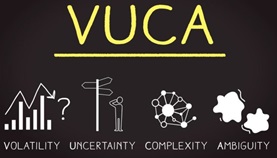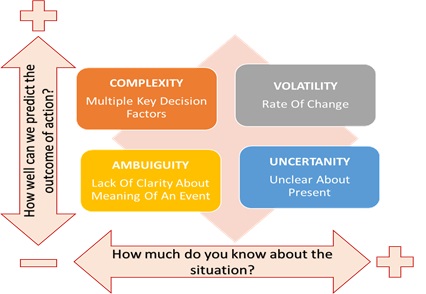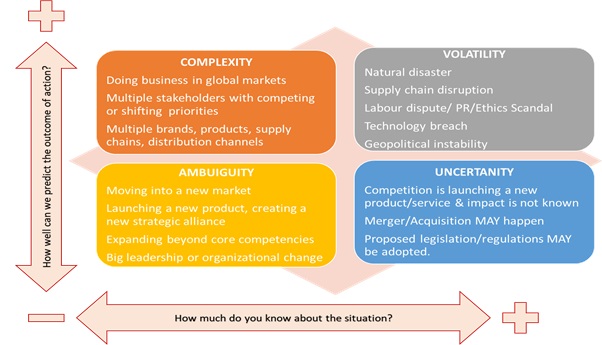
What is VUCA
VUCA is an acronym that stands for volatility, uncertainty, complexity and ambiguity, a combination of qualities that, taken together, characterize the nature of some difficult conditions and situations. The term is also sometimes said to stand for the adjectives: volatile, uncertain, complex and ambiguous.
The term VUCA originated with the United States Army War College to describe conditions resulting from the Cold War. The VUCA concept has since been adopted throughout businesses and organizations in many industries and sectors to guide leadership and strategy planning. An awareness of the forces represented in the VUCA model and strategies to mitigate the harm they might cause are integral to crisis management and disaster recovery planning.

Volatility
Volatility refers to the propensity for changing from one state to another. Under certain conditions, volatile materials can dangerously explode, changing rapidly from stable to disordered. This provides another implication that volatile conditions are dangerous conditions.
The interesting thing about volatility is that even though it might represent danger, it can also represent opportunity. The point is this: volatility is a good if you are seeking opportunities and bad if you like predictability.
Uncertainty
Uncertainty refers to the lack of specific information, which can be found by answering specific questions. Asking “What is the probability that it will rain today?” is a question that is an attempt to characterize uncertainty.
Complexity
Complexity refers to the number of components, the relationships between the components. The normal layperson’s usage of the complexity tends to oversimplify the scope of practical problems facing leaders in organizations. Complexity differs from “complicated.” A complicated issue can be understood by analysis and investigation beforehand.
Ambiguity
The Latin prefix “ambi-“refers to multiple or non-fixed, such as its use in the words ambiance and ambidextrous. Ambiguous language is language that can be interpreted differently. Ambiguity is a cause of stress for many people (especially those who work in well-structured organizations) as the disorder implied by ambiguity is not comfortable. People tend to avoid, ignore, or minimize ambiguity.
VUCA is a condition that calls for questions — lots of them. Penetrating questions that ferret out nuance. Challenging questions that stimulate differing views and debate. Open-ended questions that fuel imagination. Analytical questions that distinguish what you think from what you know. The only thing you know with certainty about your strategy is that it’s wrong. Persistent probing will help you discern if it’s off by 5 percent or 95 percent before events swiftly reveal the answer to you. Agility is critical because strategic adjustments must be made continually.
VUCA Examples

Of course, each of the four characteristics of VUCA rarely happens in isolation. For example, you might be experiencing volatility and complexity at the same time (A sudden change in leadership at the same time as your competitor launches a new product). We need to think about which of these examples and characteristics, or VUCA combinations, best describes the eco-system in which we currently do business.
Which Aspect of VUCA Do You Prioritize?
Making the ‘Shift’ Happen
Now that you have identified the characteristics of VUCA that are most relevant to your current situation and before you start thinking about specific strategies and tactics to be effective, it is time to make the mindset shift to ensure you are setting yourself up for success.
Mindset Shift: From Planning to Preparing
In stable contexts, we can rely on the tried and true practices of planning and analysis. When the future, not to mention the present, is uncertain and unpredictable, we must make a mindset shift toward preparing and enter a state of readiness.
The best practices below fall into two key and interdependent categories:
1) People and talent development strategies., and
2) Systems and processes.
They are interdependent because you can have the best systems and processes in the world and if you have not developed your people to make the necessary mindset and skill set shift, you will be disappointed in their performance when it counts most.
Which VUCA characteristics are most relevant to the challenges and opportunities you are confronting in:
- your organization?
- Department?
- Your role as a leader?
As you read the following best practices for leading through VUCA, pay particular attention to those that are within your span of control or influence.
Volatility
Characterized by an unpredictable, unstable situation, though not necessarily complicated. Information is available as events unfold.
- Train for role elasticity and develop “generalizing specialists.”
- Improve decision-speed
- Build redundancy into your system and build slack into the supply chain
- Leverage technology and alternative strategies to ensure continuous communication
- Regularly train for various disruptions, and ID needed skills, knowledge, and talent
- Tap your hi-potentials for temporary assignments
Uncertainty
Characterized by a lack of key actionable information, such as timing, duration, cause and effect.
- Tap your Relational Web to:
- Reduce uncertainty
- Gather additional information and insight, including customer data, market analytics
- Improve access to market insights via resources like slack and yammer
- Reflect on and share experiences of successfully working through uncertainty
- Identify the givens of the current situation and focus on what is within your span of control
- Provide or seek career-pathing and “stay interviews” so you can identify people’s interests and strengths to keep them engaged
- Implement agile performance appraisals and regularly provide feedback and acknowledge agile success
Complexity
Characterized by an overwhelming amount of information, interconnected or moving parts and relationships.
- Improve communication, collaboration and coordination
- Clarify decision-rights
- Adapt organizational structure and expertise to match the complexity of the context
- Identify people who have strengths and experience in dealing with complexity
- Recruit and develop people who can thrive in complexity.
Ambiguity
Characterized by a lack of information and precedent, making the ability to predict the impact of actions a challenge.
- Create (some) clarity. Make space for interactions
- Re-engage and recommit to your purpose
- Understand and prioritize user needs
- Focus on your MVP (Minimal Viable Product)
- Practice rapid prototyping to fail faster and learn quicker
- Experiment and pilot to discover what you don’t know
- Make time to learn the lessons from experience and carry them forward
Limitations: These ideas are not intended as a prescription for the issues and opportunities that are most pressing for you and your fellow agile leaders. They will help get the conversation started and lead to thoughtful strategic and tactical approaches that build your competence, capacity, and confidence to effectively lead through VUCA.
Content Curated By: Dr Shoury Kuttappa

